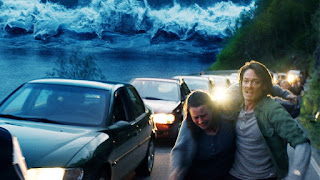As the world becomes more globalized, so does cinema. Big-budget blockbuster films, once seemingly the sole provence of Hollywood, are now regularly produced in China and India, and other film industries around the world are starting to create their own blockbusters. European films are no longer necessarily the personal auteurist projects that Americans associate with Godard, Bergman, and Fellini; those films are now joined by bigger films meant to please crowds more than provoke intense introspection.
Norwegian filmmaker Roar Uthaug's The Wave is billed as "Norway's first disaster movie," and it was a huge hit in its native country, finishing at the top of the 2015 box office (by ticket sales, one in every six Norwegians saw the film in theatres). Based on a true scenario, the film follows geologist Kristian (Kristoffer Joner) on the day is family is due to move away from Geiranger, a coastal tourist town in Geirangerfjord. Seismic activity along one of the mountain, however, triggers a landslide that results in an 80-foot wave thundering toward the town, with only ten minutes to evacuate everyone. Kristian must race against time to save his family before the wave destroys the town.
Uthaug obviously studied the art of the disaster film: his film follows all of the standard beats (occasionally to a fault), including a lengthy prelude establishing Kristian's family life and marking which characters are clearly doomed once the wave comes pummeling through the fjord. Yet the film is more than a boilerplate blockbuster, as the main characters are complex and achieve meaningful development over the course of the film, in addition to Uthaug's canny eye for stunning images. Of course, the film hardly had the budget for Hollywood-caliber effects, but Uthaug and director of photography John Christian Rosenlund create breathtaking images of disaster without the need to digitize everything. Most imporantly, Joner's performance anchors the film, imbuing his hero character with genuine awe at his tragic situation and concern for his family. It's more than just a great genre performance, it's a great performance, period. The same can be said of the film. B+
Norwegian filmmaker Roar Uthaug's The Wave is billed as "Norway's first disaster movie," and it was a huge hit in its native country, finishing at the top of the 2015 box office (by ticket sales, one in every six Norwegians saw the film in theatres). Based on a true scenario, the film follows geologist Kristian (Kristoffer Joner) on the day is family is due to move away from Geiranger, a coastal tourist town in Geirangerfjord. Seismic activity along one of the mountain, however, triggers a landslide that results in an 80-foot wave thundering toward the town, with only ten minutes to evacuate everyone. Kristian must race against time to save his family before the wave destroys the town.
Uthaug obviously studied the art of the disaster film: his film follows all of the standard beats (occasionally to a fault), including a lengthy prelude establishing Kristian's family life and marking which characters are clearly doomed once the wave comes pummeling through the fjord. Yet the film is more than a boilerplate blockbuster, as the main characters are complex and achieve meaningful development over the course of the film, in addition to Uthaug's canny eye for stunning images. Of course, the film hardly had the budget for Hollywood-caliber effects, but Uthaug and director of photography John Christian Rosenlund create breathtaking images of disaster without the need to digitize everything. Most imporantly, Joner's performance anchors the film, imbuing his hero character with genuine awe at his tragic situation and concern for his family. It's more than just a great genre performance, it's a great performance, period. The same can be said of the film. B+

Comments